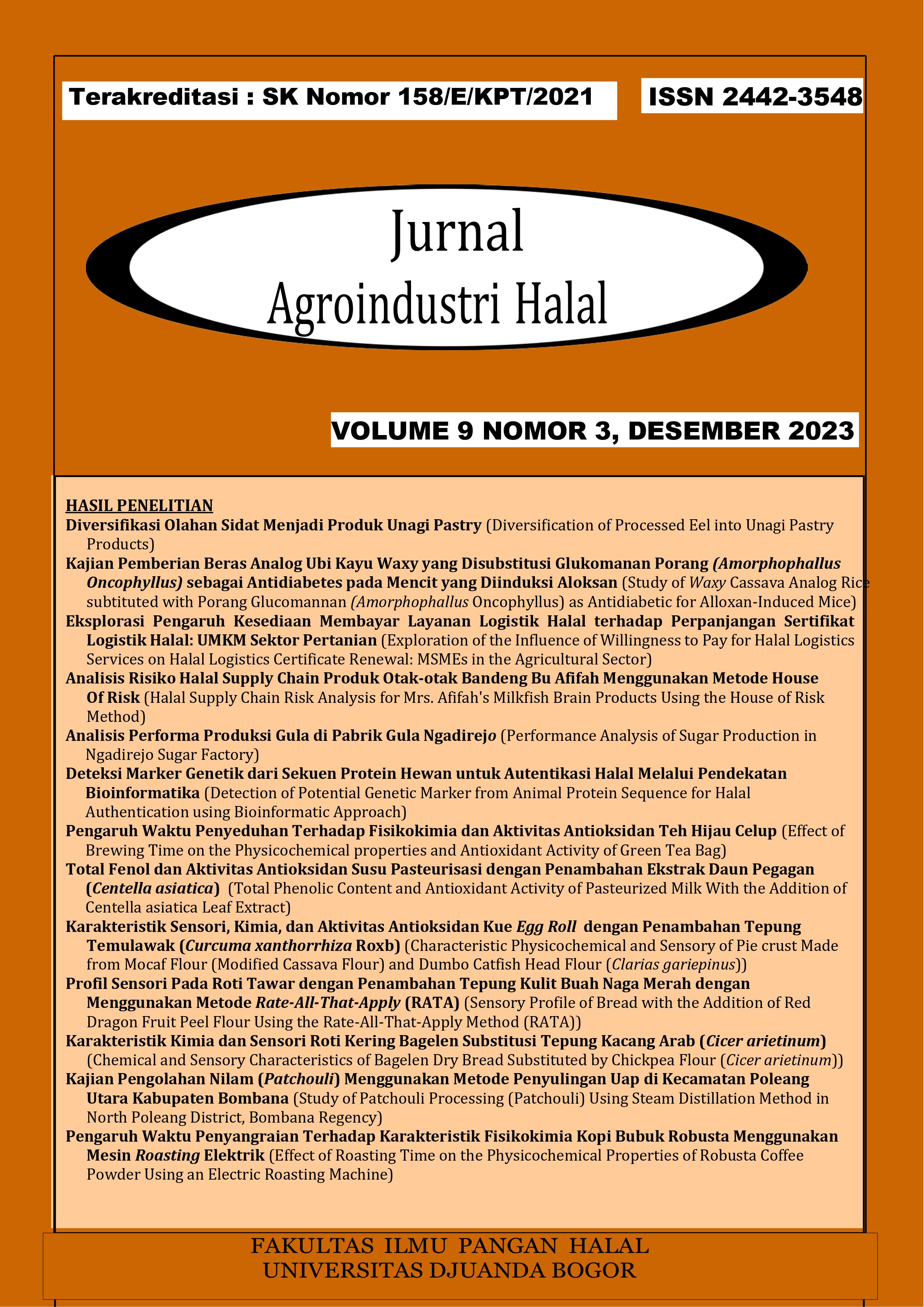Kajian Pengolahan Nilam (Patchouli) Menggunakan Metode Penyulingan Uap di Kecamatan Poleang Utara Kabupaten Bombana
DOI:
https://doi.org/10.30997/jah.v9i3.6404Keywords:
Processing; patchouli oil; steam distillation;Abstract
This study examines the processing of patchouli oil using the steam distillation method in North Poleang District, Bombana Regency. Data collection methods: (a) observation; (b) interviews); (c) questionnaires; and (d) documentation. The method in this study is to describe the processing of patchouli oil using the steam distillation method. The results showed the processing of patchouli oil using the steam distillation method in North Poleang District, Bombana Regency. Distilleries are used with water and steam distillation systems. Distil water and steam through a kettle filled with water to the limit of the filter and patchouli leaves on the filter. Then the water is heated and produces steam passing through the material and flowing through a stainless pipe. (a) Patchouli oil is obtained from the leaves, stalks, stems and patchouli plants. Harvesting can be done 6 - 8 months after planting in plants that grow well. Nilan harvest is usually done by pruning as high as 10 - 20 cm from the ground. Production of the first leaves and twigs is still low (about 50 - 75% of normal production). Done every 4 - 6 months depending on the rainfall and soil fertility; (b) drying is usually carried out by drying, the crop (pattern leaves and stalks) are dried in the sun for 5 hours followed by wind-drying for 2 - 3 days until the moisture content reaches 12 - 15%; and (c) direct steam distillation, in which the material is in a still boiler and water vapour is drained from the boiler at the bottom of the distillate. The duration of direct steam distillation ranges from 4-6 hours.
References
Herdhiansyah, D., Sutiarso, L., Purwadi, D. & Taryono. (2012). Analisis Potensi Wilayah untuk Pengembangan Perkebunan Komoditas Unggulan di Kabupaten Kolaka Sulawesi Tenggara. Jurnal Teknologi Industri Pertanian, 22(2), 106-114.
Herdhiansyah, D., & Asriani. (2018). Strategi Pengembangan Agroindustri Komoditas Kakao di Kabupaten Kolaka – Sulawesi Tenggara. Jurnal Agroindustri Halal, 4(1), 30-41. http://dx.doi.org/10.30997/jah.v4i1.1124.
Herdhiansyah, D., Gustina, Ab., Patadja, Asriani. (2021). Kajian Penerapan Good Manufacturing Practices (GMP) pada Pengolahan Keripik Pisang. Jurnal Teknologi Industri Pertanian, 15 (3), 845-853.
Herdhiansyah, Dhian, Fitrawaty, Tamrin dan Asriani. (2022). Penerapan Sistem GMP (Good Manufacturing Practices) pada Usaha Mikro Tahu Tempe Benjo di Desa Lambusa Kabupaten Konawe Selatan. Jurnal Warta Industri Hasil Pertanian, 39(1), 9 – 15.
Krismawati, A. (2005). Nilam dan Potensi Pengembangannya Kalteng Jadikan Komoditas Rintisan. Diakses di http://www.litbang.pertanian.go.id/artikel/91/pdf/
Mangun. (2007). Analisis Alat Penyulingan pada Penyulingan pada Perkebunan Nilam. [Skripsi, Institut Pertanian Bogor]. IPB University Scientific Repository.
Mauludi, & Asman. (2005). Analisis Usahatani di Desa Laantula Jaya Kecamatan Witaponda Kabupaten Morowali. Jurnal Agrotekbis. 4(3), 350 - 355.
Patong. (1993). Analisis Pendapatan Usaha. Penebar Swadaya.
Badan Litbang Pertanian, (2008). Teknologi Budidaya Nilam. Balai Besar Pengkajian dan Pengembangan Teknologi Pertanian.
Ramayana, & Agustiar. (2014). Pengaruh Jenis Bahan Alat Suling dan Lama Pengeringan Daun Nilam Terhadap Mutu Minyak Nilam. Teknik Kimia, ITM.
Ramayanti, D., Harmawan, T., & Rahmatul, F. R. (2021). Analisis Kadar Patchouli Alcohol Menggunakan Gas Chromatography-Mass Spectrometry (GC-MS) pada Pemurnian Minyak Nilam (Pogostemon Cablin B.) Aceh Tamiang Dengan Nanomontmorillonite. Al-Kimiya: Jurnal Ilmu Kimia dan Terapan, 8 (2), 68-74.
Sieng, T. H. (1992). Minyak Atsiri. Balai Penelitian Kimia PNPR. Nupika-Yasa Deperindag. Penerbit Kantor dan Penyuluhan Deperindag.
Shinta, S. (2012). Potensi Minyak Atsiri Daun Nilam (Pogostemon cablin Benth), Daun Babadotan (Ageratum conyzoides L), Bunga Kenanga (Cananga odorata hook F & Thoms), dan Daun Rosemarry (Rosmarinus officinalis L) sebagai Repelan Terhadap Nyamuk Aedes Aegypti L. Media Litbang Kesehatan, 22(2), 61-69.
Downloads
Published
How to Cite
Issue
Section
License
Copyright (c) 2023 dhian herdhiansyah, Subhan, La Rianda, Asriani

This work is licensed under a Creative Commons Attribution-ShareAlike 4.0 International License.
Authors who publish with Jurnal Agroindustri Halal agree to the following terms:
- Authors retain copyright and grant the journal right of first publication with the work simultaneously licensed under a Creative Commons Attribution 4.0 International License that allows others to share the work with an acknowledgement of the work's authorship and initial publication in Jurnal Agroindustri Halal.
- Authors are able to enter into separate, additional contractual arrangements for the non-exclusive distribution of the journal's published version of the work (e.g., post it to an institutional repository or publish it in a book), with an acknowledgement of its initial publication in Jurnal Agroindustri Halal.
- Authors are permitted and encouraged to post their work online (e.g., in institutional repositories or on their website) prior to and during the submission process, as it can lead to productive exchanges, as well as earlier and greater citation of published work








